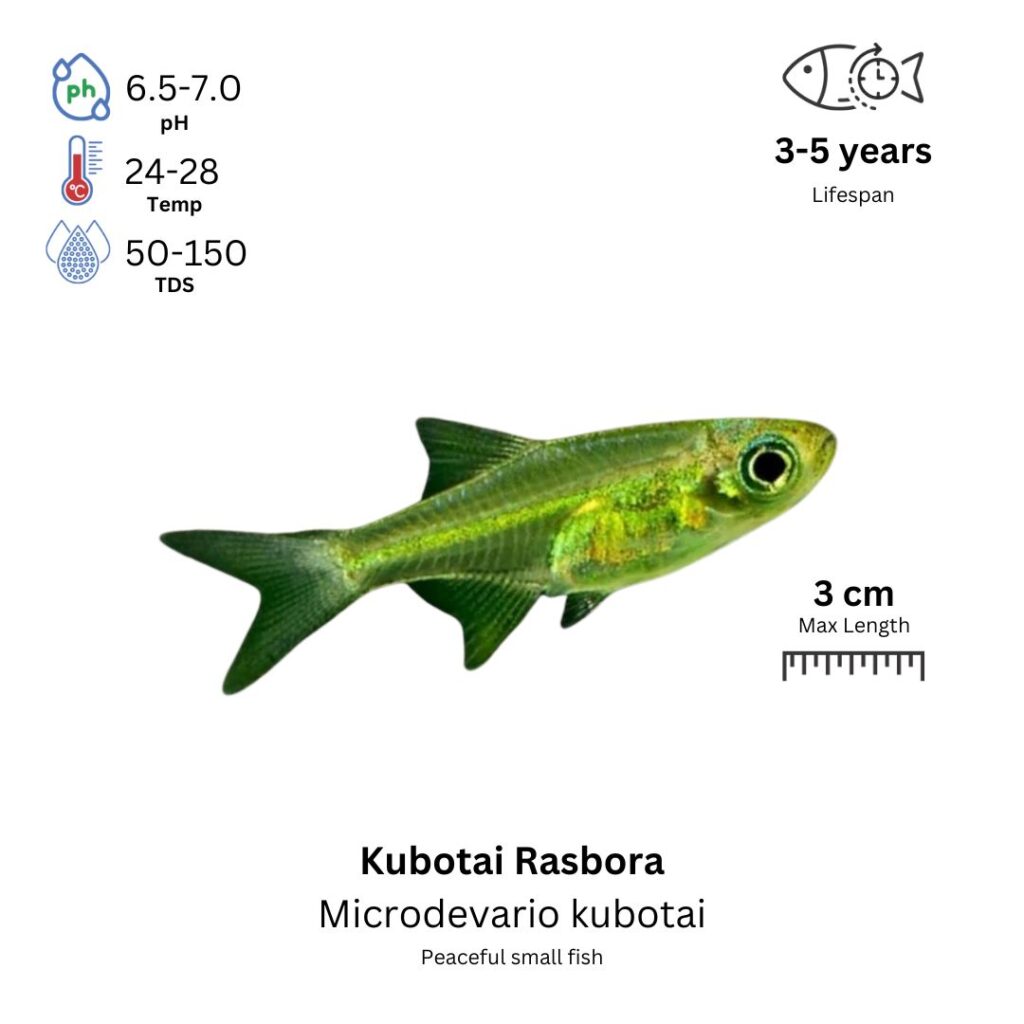Kubotai Rasbora
Microdevario kubotai

Description
The Kubotai Rasbora is a small, vibrant fish known for its peaceful nature and striking coloration. It has a translucent, light body with a distinctive red-orange coloration along its fins and a slightly darker, reddish hue that intensifies in males, particularly along the dorsal and tail fins. Females are typically more subdued in coloration, but still retain the vivid red and orange accents. Their tiny size and shimmering body make them an attractive species for smaller aquariums or nano tanks. These fish are peaceful and social, thriving in schools where they feel secure and exhibit their natural behavior. Kubotai Rasboras are active swimmers, often found darting through plants and grazing on microalgae.
Habitat Origin
Native to the freshwater streams and rivers of Southeast Asia, specifically found in parts of Malaysia and Thailand. They inhabit slow-moving, clear waters with dense vegetation, where they prefer to swim in groups near the middle or upper levels of the tank.
Aquarium
Ideal Number in Aquarium: At least 6 individuals, as they are schooling fish and feel more secure in groups.
Favorite Food

Kubotai Rasboras are omnivores and will accept a variety of foods, including high-quality flake food, micro pellets, and live or frozen foods like brine shrimp, daphnia, and bloodworms. They will also graze on algae and small organic matter in the tank, making them suitable for planted setups.
Behavior:
Kubotai Rasboras are peaceful and social, thriving in groups. They are generally non-aggressive, but they can be shy and will feel more comfortable in a tank with plenty of hiding spots. Their schooling nature means they exhibit natural behaviors and vibrant colors when housed with other members of their species. They prefer to swim in the middle to upper levels of the tank, where they can be seen darting gracefully among plants or decorations. These fish are best kept in schools of 6 or more to reduce stress and promote their natural activity level.
Special Care:
Kubotai Rasboras thrive in a well-planted aquarium with plenty of hiding spots, such as plants, driftwood, or rocks. A soft substrate, like fine sand or smooth gravel, is ideal for these small fish. Regular water changes and good filtration are essential to maintain water quality, as these fish are sensitive to poor water conditions. They do well in tanks with moderate water flow and should be housed in a tank that mimics their natural environment, with plenty of cover and stable water parameters.
Compatibility with Other Fish:
Yes, Kubotai Rasboras are ideal for community tanks with other small, peaceful fish such as tetras, other rasboras, and small catfish. They should be kept with non-aggressive species and avoided with larger or more aggressive fish that may intimidate them. Due to their small size and peaceful nature, they are best kept with species that occupy different levels of the tank, such as bottom-dwellers or mid-level swimmers.
Breeding Setup
Using a dedicated breeding tank is recommended for Kubotai Rasboras to ensure better water control and prevent egg predation. A 5-gallon tank (19 liters) is sufficient for a small group, while a 10-gallon tank (38 liters) works better for multiple pairs. Maintain slightly acidic to neutral water with pH 5.5–7.5, temperature 24–28°C (75–82°F), and hardness 2–10 dGH. Equip the tank with a gentle sponge filter, and use fine gravel or sand as substrate. Add Java moss, Hornwort, or Anubias, along with floating plants like Water Sprite, to give eggs and fry shelter. Lighting should be moderate, on a 12-hour light/dark cycle.
Conditioning for Breeding
To prepare Kubotai Rasboras for spawning, provide a nutritious, varied diet including high-quality flakes or micro pellets, live or frozen brine shrimp, daphnia, bloodworms, and vegetable-based foods like finely chopped spinach or peas. Weekly 20–30% water changes are important for maintaining health. To trigger spawning, do a larger water change (~50%) and increase the temperature to around 28°C, mimicking rainy season cues that stimulate breeding behavior.
Spawning Process
Spawning typically happens early in the morning or after water adjustments. Males display vibrant colors and court females by swimming alongside them. A female may lay 10–30 small, sticky eggs that attach to plants, rocks, or decorations. Once spawning is complete, remove the adult fish to prevent them from eating the eggs or fry. Egg scattering behavior means eggs will be hidden throughout the tank.
Fry Care
The eggs hatch in about 24–36 hours, depending on water temperature. After hatching, fry absorb their yolk sacs for the first few days. Once free-swimming, they should be fed infusoria or liquid fry food, and as they grow, baby brine shrimp, microworms, or finely crushed flakes. Perform 10–20% water changes daily or every other day, maintain stable temperature (24–28°C), and avoid overfeeding, as waste buildup can quickly deteriorate water quality and harm the fry.
Key Considerations
Kubotai Rasboras reach sexual maturity at 6–12 months. Males are smaller and more colorful, especially during courtship, while females are rounder and paler, particularly when gravid. Avoid sudden changes in pH, temperature, or hardness, and ensure a peaceful, clean environment with proper filtration. Good water quality and low stress are critical for breeding success and fry survival.
